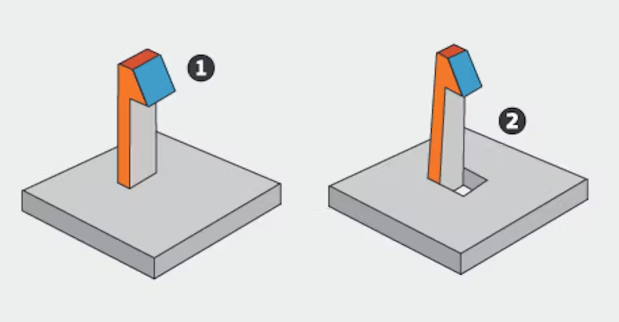
In the world of injection molding, understanding the nuances of part design and mold construction is critical for producing high-quality components. One such essential aspect is the concept of undercuts. This article delves into what undercuts are, their significance in injection molding, and how they are managed in the manufacturing process.
Understanding Undercuts in Injection Molding
Definition
An undercut in injection molding refers to any feature of a molded part that obstructs its straight ejection from the mold. These features create areas where the mold’s geometry extends inward or outward, preventing the part from being released without additional mechanisms or mold actions.
Types of Undercuts
- Internal Undercuts: These are features that protrude inward into the part’s interior, such as holes, slots, or threads.
- External Undercuts: These extend outward from the part’s surface, like lips, latches, or hooks.
- Complex Undercuts: These combine both internal and external elements, creating intricate geometries that require sophisticated mold designs.
Importance of Undercuts in Injection Molding
Design Flexibility
Undercuts enable more complex and functional part designs. They allow for the creation of features such as snap-fits, hinges, and interlocking components, which are crucial for many applications, especially in the automotive, consumer goods, and electronics industries.
Enhanced Product Performance
Features created by undercuts can improve the mechanical performance of parts. For example, snap-fit joints and threaded sections provide secure and functional assemblies without the need for additional fasteners or adhesives.
[elementor-template id=”4330″]
Aesthetic Appeal
Undercuts can also enhance the visual and tactile properties of a part. They allow for the inclusion of intricate details and textures that would be impossible with a simple straight-pull mold, thus adding value through improved product aesthetics.
Challenges of Undercuts in Injection Molding
Mold Complexity
Creating molds that accommodate undercuts increases the complexity of the mold design. Special mechanisms such as side actions, lifters, or collapsible cores are often required, leading to more intricate and costly mold constructions.
Increased Costs
The complexity added by undercuts typically results in higher tooling and production costs. More sophisticated molds and additional processing steps can increase both the time and expense involved in manufacturing.
Ejection Difficulties
Undercuts make the ejection of parts from the mold more challenging. Traditional ejection methods may not suffice, necessitating the use of advanced mechanisms to release the parts without damaging the mold or the parts themselves.
[elementor-template id=”4331″]
Strategies for Addressing Undercuts in Injection Molding
Draft Angles
Incorporating draft angles into the design of undercut features can facilitate easier part ejection. Draft angles help by allowing the part to release from the mold without excessive force, thus reducing the risk of part damage or mold wear.
Side Actions
Side actions, or side cores, are components of the mold that move perpendicularly to the parting line to form and release undercuts. These mechanisms slide in and out of the mold to create the necessary features, then retract to allow part ejection.
Lifters
Lifters, or angled ejector pins, move within the mold to release undercuts. They lift or shift the part away from the mold wall, enabling the part to be ejected without damaging the undercut features.
Unscrewing Mechanisms
For parts with threaded features, unscrewing mechanisms rotate the part within the mold to disengage the threads before ejection. This approach is commonly used for producing caps, closures, and threaded fasteners.
Core Pulling
Core pulling involves movable cores that create and retract from holes, recesses, or indentations in the part. These cores move out of the way during ejection, allowing the part to be released from the mold without interference.
Practical Example
Consider the production of a plastic bottle cap with internal threads:
- Design: The cap includes internal threads, creating an internal undercut that requires an unscrewing mechanism for ejection.
- Mold Construction: The mold is equipped with a rotating core that forms the threads. After the plastic solidifies, the core unscrews, releasing the cap without damaging the threads.
- Production Process: During the injection molding cycle, the core rotates to disengage the threads, then the cap is ejected smoothly from the mold.
Conclusion
Undercuts in injection molding are essential for creating complex, functional, and aesthetically pleasing parts. However, they also introduce challenges in mold design, manufacturing costs, and part ejection. By utilizing strategies such as draft angles, side actions, lifters, and unscrewing mechanisms, manufacturers can effectively manage undercuts and produce high-quality plastic parts. Understanding and addressing the intricacies of undercuts allows for greater design flexibility and enhanced product performance, making it a crucial aspect of advanced injection molding practices
Related Conten: Die Casting / Plastic Molds Manufacturing
 DTG Mould Trade Process |
|
| Quote: | According to sample, drawing and specific requirement. |
|---|---|
| Discussion | Mold material, cavity number, price, runner, payment, etc. |
| S/C Signature | Approval for all the items. |
| Advance | Pay 50% by T/T |
| Product Design Checking | We check the product design. If some position is not perfect, or can not be done on the mould, we will send customer the report. |
| Mold Processing | Send report to customer once each week |
| Mold Testing | Send trial samples and try-out report to customer for confirmation |
| Mold Modification | According to customer’s feedback. |
| Balance Settlement | 50% by T/T after the customer approved the trial sample and mould quality. |
| Delivery | Delivery by sea or air. The forwarder can be designated by your side. |
 |
|

